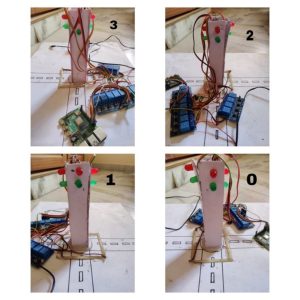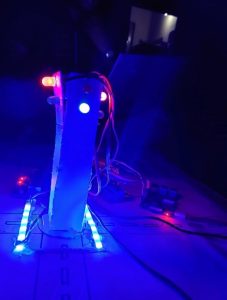 Research Scholars Chetan Mylapilli, Jethin Sai Chilukuri, Rohith Kumar Akula, Sana Fathima, and Assistant Professor Dr Anirban Ghosh from the Department of Electronics and Communication Engineering at SRM University-AP have co-authored an innovative paper titled “A System and Method for Detecting Density-Based Intelligent Parallel Traffic.” This pioneering research delves into the development of an intelligent traffic control system that dynamically adjusts traffic signals based on real-time vehicle density analysis, their research with the patent no- 202241044904 represents a significant step in integrating technology with transportation efficiency.
Research Scholars Chetan Mylapilli, Jethin Sai Chilukuri, Rohith Kumar Akula, Sana Fathima, and Assistant Professor Dr Anirban Ghosh from the Department of Electronics and Communication Engineering at SRM University-AP have co-authored an innovative paper titled “A System and Method for Detecting Density-Based Intelligent Parallel Traffic.” This pioneering research delves into the development of an intelligent traffic control system that dynamically adjusts traffic signals based on real-time vehicle density analysis, their research with the patent no- 202241044904 represents a significant step in integrating technology with transportation efficiency.
Abstract
This work presents an intelligent traffic control system that addresses the gaps in the current state-of-the-art by using a novel hardware-software integration. The system evaluates traffic density in each lane direction and dynamically adjusts traffic lights using a computational algorithm to significantly reduce waiting times at junctions. It also ensures safe pedestrian movement and enables parallel traffic flows. A Raspberry Pi serves as the system’s control unit, utilizing video processing to determine traffic density, while LEDs simulate the traffic lights. The system integrates various hardware and software components, including Raspberry Pi, LEDs, relay modules, VNC software, and sample traffic videos, to provide an efficient solution to the traffic management problem.
Explanation of Research in Layperson’s Terms
The current system uses a Raspberry Pi to control traffic lights based on real-time video of cars at intersections. It detects how many vehicles are in each lane and adjusts the lights to reduce waiting time. Pedestrian safety is managed by ensuring safe crossing times. LED lights simulate the traffic signals, and the system allows smoother traffic flow by handling vehicles moving in parallel. However, it can’t yet control turning vehicles or prioritize emergency vehicles.
Practical Implementation of the Research
The intelligent traffic control system significantly reduces congestion by dynamically adjusting traffic signals, leading to shorter wait times and smoother commutes. It helps lower pollution and fuel consumption by minimizing idle time at junctions, contributing to better air quality and conservation of resources. Pedestrian safety is improved through designated crossing times, reducing accidents. The system also supports economic growth by cutting time wasted in traffic, enhancing productivity.
Future Research Plans
Future research will focus on adding control for turning traffic and distinguishing between different vehicle types to enable emergency vehicle priority. To improve real-time video processing, the system will transition from Raspberry Pi to more efficient hardware like FPGAs or GPUs. Machine learning will be explored for better vehicle detection and traffic signal optimization. Integration with V2X communication will enhance traffic management, and real-world scalability will be tested for deployment in smart city environments.
The prototype:



Figure 1. Image of the prototype
Figure 2. Working prototype
Figure 3. Block Diagram of the prototype

